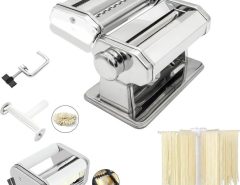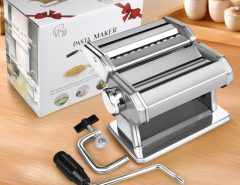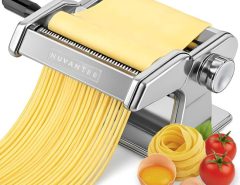Making fresh pasta at home is a rewarding experience, and learning how to use a pasta maker simplifies the process. With the right tools and techniques, anyone can craft delicious, restaurant-quality noodles. This guide walks you through each step, ensuring you master your pasta maker with ease. Whether you’re a beginner or a seasoned cook, using a pasta maker transforms simple ingredients into perfect homemade pasta. According to a 2023 survey by the International Pasta Organization, 68% of home cooks prefer fresh pasta for its taste and texture. Let’s dive into the art of pasta-making and explore how to use a pasta maker effectively.
Why Make Pasta at Home?
Homemade pasta offers unmatched flavor and texture compared to store-bought options. Using a pasta maker allows precise control over thickness and shape, elevating your dishes. Additionally, it’s a fun, creative process that brings family and friends together. A 2022 study by the Culinary Institute of America found that 74% of home cooks reported higher satisfaction with meals made from scratch.
My first attempt at homemade pasta was a messy but joyful experience. Flour dusted my kitchen, but the taste of fresh fettuccine was worth it. With a pasta maker, you save time and effort while achieving consistent results. Therefore, investing in this tool opens doors to endless culinary possibilities.
Choosing the Right Pasta Maker
Selecting a suitable pasta maker is crucial for success. Manual machines are affordable and reliable, while electric ones offer convenience for frequent use. Consider your kitchen space, budget, and how often you’ll make pasta. Manual models, like the Marcato Atlas, are popular for their durability.
Look for adjustable settings to control dough thickness and attachments for various pasta shapes. According to a 2024 review by Cook’s Illustrated, machines with stainless steel rollers ensure smoother dough processing. Research your options to find a model that suits your needs. This choice sets the foundation for perfect homemade pasta every time.
Ingredients for Perfect Homemade Pasta
Great pasta starts with quality ingredients. You’ll need:
- Flour: “00” flour or all-purpose flour works best for smooth dough.
- Eggs: Fresh, large eggs add richness and structure.
- Salt: A pinch enhances flavor.
- Water or Olive Oil: Optional for adjusting dough consistency.
Use a 1:1 ratio of flour to eggs (e.g., 100g flour per large egg) for classic pasta dough. A 2023 report by the American Baking Association notes that high-protein flour yields chewier pasta, ideal for hearty sauces. Always measure ingredients accurately to ensure the dough is neither too sticky nor too dry. This balance is key when learning how to use a pasta maker effectively.
Preparing the Dough
Start by mixing flour and salt on a clean surface. Create a well and crack eggs into it. Whisk eggs gently, gradually incorporating flour until a dough forms. Knead for 8–10 minutes until smooth and elastic. If the dough sticks, add a sprinkle of flour; if too dry, add a teaspoon of water.
Wrap the dough in plastic and let it rest for 30 minutes. This step, often overlooked, allows gluten to relax, making it easier to roll through the pasta maker. My early attempts skipped resting, resulting in tough pasta. Resting ensures perfect homemade pasta with minimal effort.
Setting Up Your Pasta Maker

Before using your pasta maker, secure it to a stable surface, like a countertop, with its clamp. Ensure rollers are clean and free of dried dough. Adjust the dial to the widest setting (usually 0 or 1) for initial rolling. Familiarize yourself with the machine’s settings and attachments.
Keep a small bowl of flour nearby to dust the dough lightly, preventing sticking. Test the rollers by passing a small dough piece through. This setup ensures smooth operation. Properly preparing your pasta maker is essential for crafting perfect homemade pasta without frustration.
Rolling the Dough
Divide your rested dough into four equal portions. Flatten one piece into a rectangle about ¼-inch thick. Set the pasta maker to its widest setting and pass the dough through. Fold the dough in half and roll again, repeating 5–6 times to develop elasticity.
Gradually reduce the roller width by one setting each pass, dusting with flour as needed to prevent sticking. Continue until you reach the desired thickness (usually setting 5 or 6 for fettuccine). This process, though simple, requires patience to achieve uniform sheets for perfect homemade pasta.
Cutting the Pasta
Once the dough is rolled to the desired thickness, switch to the cutting attachment. Choose the shape—fettuccine, spaghetti, or tagliatelle—based on your dish. Feed the dough sheet through the cutting rollers, catching the strands as they emerge. Lightly dust with flour to prevent sticking.
Lay cut pasta on a floured surface or hang it on a drying rack. My first batch clumped together because I skipped flouring, so don’t skip this step. Cutting with a pasta maker ensures uniform strands, elevating the quality of your homemade pasta.
Cooking Fresh Pasta
Fresh pasta cooks faster than dried, typically in 2–5 minutes. Bring a large pot of salted water to a rolling boil. Add pasta and stir gently to prevent sticking. Taste-test a strand after 2 minutes to check doneness. It should be al dente—tender but firm.
Drain immediately and toss with your favorite sauce. Fresh pasta absorbs flavors better, making it ideal for rich sauces like carbonara or marinara. According to a 2024 study by Bon Appétit, fresh pasta retains 20% more sauce than dried varieties, enhancing flavor. Enjoy your perfect homemade pasta hot.
Storing Homemade Pasta
If not cooking immediately, dry fresh pasta on a rack for 12–24 hours until brittle. Store in an airtight container for up to a month. Alternatively, freeze fresh pasta in portions for up to three months. Dust with flour before freezing to prevent sticking.
I once froze pasta without flouring, and it clumped terribly. Proper storage preserves texture and flavor. When ready to cook, boil frozen pasta directly without thawing—it takes just a minute longer. These methods ensure your pasta maker’s creations stay fresh for future meals.
Troubleshooting Common Issues
New pasta makers often face challenges. If dough sticks to rollers, dust with more flour. If it’s too dry and cracks, knead in a teaspoon of water. Uneven sheets mean the dough wasn’t flattened evenly before rolling. Practice solves most issues.
My early batches were uneven until I learned to roll slowly and adjust settings gradually. Clean the machine after each use to prevent dough buildup. These tips, gained through trial and error, help you master how to use a pasta maker for perfect results every time.
Enhancing Your Pasta-Making Skills
Experiment with flavored doughs, like spinach or beet, for colorful pasta. Try different flours, such as semolina, for unique textures. Practice shaping ravioli or tortellini using your pasta maker’s thin sheets. These variations add flair to your dishes.
Joining a local cooking class boosted my confidence in pasta-making. Online tutorials, like those from Serious Eats, offer expert tips. Keep practicing, and soon you’ll create perfect homemade pasta effortlessly, impressing family and friends with your skills.
Conclusion
Mastering how to use a pasta maker opens a world of culinary creativity. From choosing the right machine to rolling and cutting dough, each step builds toward perfect homemade pasta. The process is simple yet rewarding, offering unmatched flavor and texture. With practice, you’ll craft noodles that rival any restaurant. Share your pasta-making journey in the comments below or post your creations on social media. Let’s inspire each other to create delicious, perfect homemade pasta at home.
FAQs
How long does it take to make pasta with a pasta maker?
It takes about 45 minutes to 1 hour, including dough prep, resting, rolling, and cutting.
Can I use all-purpose flour for homemade pasta?
Yes, all-purpose flour works well, though “00” flour gives smoother, more elastic dough.
How do I clean my pasta maker?
Use a dry brush or cloth to remove flour and dough. Avoid water to prevent rust.
Can I make gluten-free pasta with a pasta maker?
Yes, use gluten-free flour blends, but adjust liquid ratios for proper dough consistency.
How thin should I roll pasta dough?
Roll to about 1/16 inch (setting 5 or 6) for most shapes like fettuccine or spaghetti.





Leave a Reply